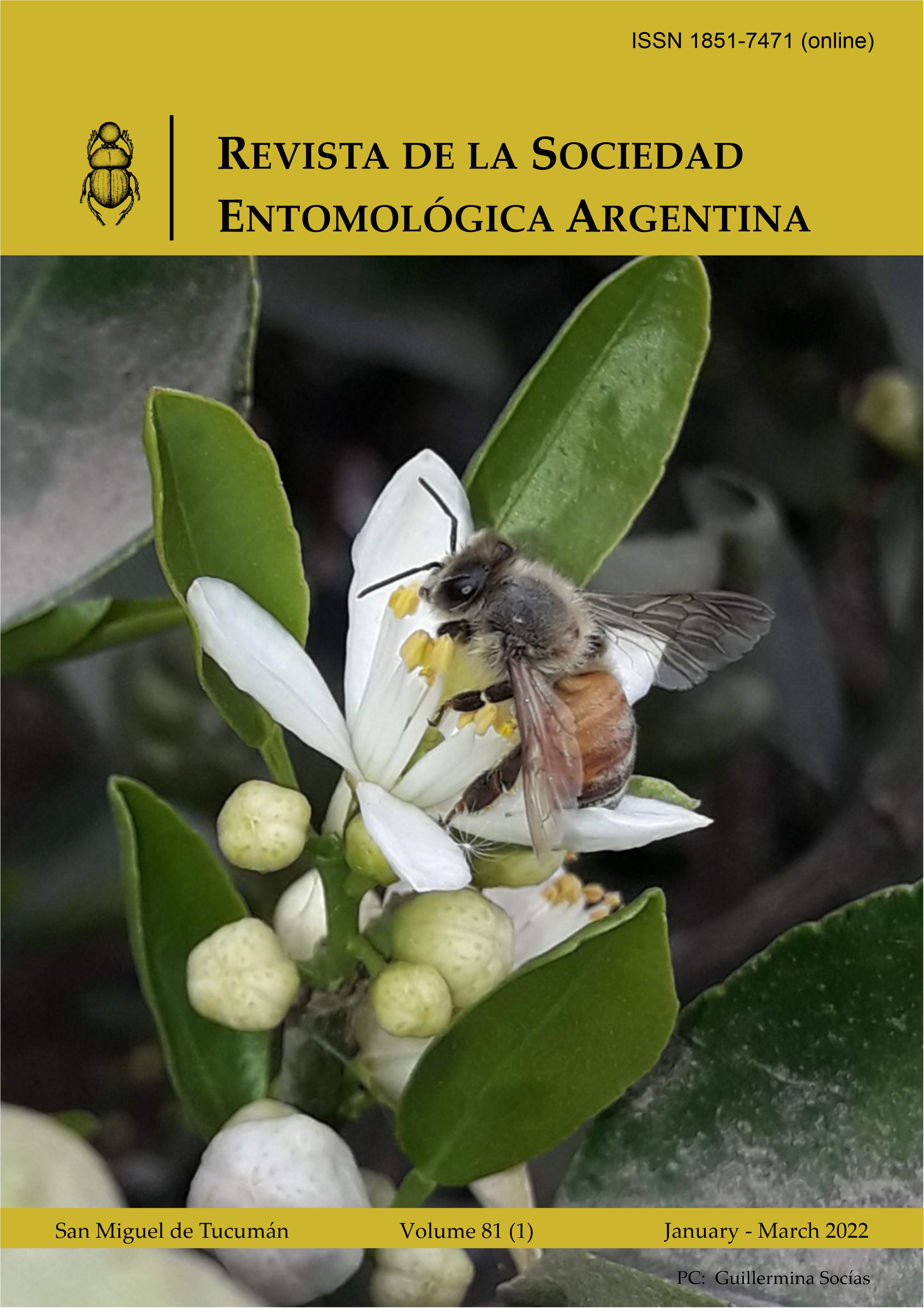Ver ítem
- xmlui.general.dspace_homeCentros Regionales y EEAsCentro Regional Entre RíosEEA ConcordiaArtículos científicosxmlui.ArtifactBrowser.ItemViewer.trail
- Inicio
- Centros Regionales y EEAs
- Centro Regional Entre Ríos
- EEA Concordia
- Artículos científicos
- Ver ítem
Dinámica temporal de Epormenis cestri Berg (Hemiptera: Flatidae) y su asociación con los componentes del paisaje del Litoral entrerriano
Resumen
La afección denominada "Mal del Río" (MDR) se trata de una intoxicación a las larvas de abejas melíferas originada por un compuesto proveniente del género Sebastiania Spreng y concentrados en los exudados de Epormenis cestri Berg. Nuestro objetivo fue determinar la dinámica temporal del ciclo de vida de E. cestri, su asociación con los componentes predominantes de la vegetación predominante y la influencia del río Uruguay sobre el tamaño de sus
[ver mas...]
La afección denominada "Mal del Río" (MDR) se trata de una intoxicación a las larvas de abejas melíferas originada por un compuesto proveniente del género Sebastiania Spreng y concentrados en los exudados de Epormenis cestri Berg. Nuestro objetivo fue determinar la dinámica temporal del ciclo de vida de E. cestri, su asociación con los componentes predominantes de la vegetación predominante y la influencia del río Uruguay sobre el tamaño de sus poblaciones. Para esto seleccionamos 5 sitios en las cercanías del río Uruguay donde se muestrearon poblaciones de E. cestri mediante la técnica Stem-tap modificada para tal fin. Se evaluó el efecto de los componentes del paisaje sobre la abundancia de E. cestri utilizando GLMM. Como resultados, se determinó que la eclosión de los huevos de E. cestri fue a mediados de octubre, encontrando una distribución escalonada de sus fenofases. Además, encontramos efectos significativamente negativos de la cobertura del bosque Espinal y del aumento de la distancia las márgenes del río Uruguay sobre la abundancia total de E. cestri. Este trabajo muestra los primeros indicios para la comprensión de cómo los componentes del paisaje estructuran las poblaciones de E. cestri, permitiendo predecir el momento crítico de incidencia de MDR.
[Cerrar]
The condition called "river disease" (MDR by its acronym in Spanish) is an intoxication in immature stages of honey bees caused by a compound from the genus Sebastiania Spreng and concentrated in the exudates of Epormenis cestri Berg. Our objective was to determine the temporal dynamics of the life cycle of E. cestri, its association with the predominant vegetation components and the influence of the Uruguay river on the size of its populations. With this
[ver mas...]
The condition called "river disease" (MDR by its acronym in Spanish) is an intoxication in immature stages of honey bees caused by a compound from the genus Sebastiania Spreng and concentrated in the exudates of Epormenis cestri Berg. Our objective was to determine the temporal dynamics of the life cycle of E. cestri, its association with the predominant vegetation components and the influence of the Uruguay river on the size of its populations. With this aim, we selected 5 sites in the vicinity of the Uruguay river where populations of E. cestri were sampled using the Stem-tap technique modified for this purpose. The effect of landscape components on the abundance of E. cestri was evaluated using GLMM. It was determined that the hatching of the E. cestri eggs was in mid-October, finding a staggered distribution of its phenophases. In addition, we found significantly negative effects of the Espinal forest cover and the increase in the distance from the banks of the Uruguay river on the total abundance of E. cestri. This work shows some first clues for the understanding of how the components of the landscape structure the populations of E. cestri, allowing to predict the critical moment of incidence of MDR.
[Cerrar]

Autor
Fuente
Revista de la Sociedad Entomológica Argentina 81 (1) : 41- 51 (2022)
Fecha
2022
Editorial
Sociedad Entomológica Argentina
ISSN
1851-7471
Documentos Relacionados
Formato
pdf
Tipo de documento
artículo
Proyectos
(ver más)
INTA/2019-PE-E1-I017-001/2019-PE-E1-I017-001/AR./DESARROLLO DEL SECTOR APÍCOLA ORGANIZADO, SUSTENTABLE Y COMPETITIVO
Palabras Claves
Derechos de acceso
Abierto
 Excepto donde se diga explicitamente, este item se publica bajo la siguiente descripción: Creative Commons Attribution-NonCommercial-ShareAlike 2.5 Unported (CC BY-NC-SA 2.5)
Excepto donde se diga explicitamente, este item se publica bajo la siguiente descripción: Creative Commons Attribution-NonCommercial-ShareAlike 2.5 Unported (CC BY-NC-SA 2.5)


